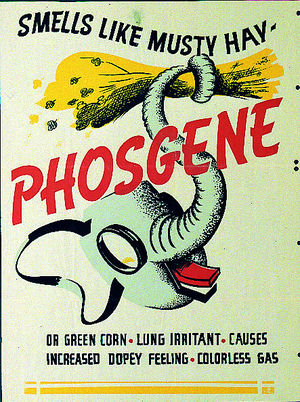We need you! Join our contributor community and become a WikEM editor through our open and transparent promotion process.
Phosgene
From WikEM
Not to be confused with phosgene oxime (CX)
Contents
Background
- phosgene (COCl2) is a highly toxic, colorless gas or liquid
- Classified as a pulmonary chemical agent, chemical weapon
- gained infamy in WWI - responsible for 85% of deaths due to chemical weapons
- pulmonary irritant
- major complication is non-cardiogenic pulmonary edema
- used in chemical reactions - large scale exposures usually 2/2 industrial accidents
- manufacturers of dyes, resins, coal tar, pesticides
- Denser than air, settles in low-lying places – trenches/basements
- Rapid olfactory fatigue can occur leading to prolonged exposure
- Exposure may be secondary to fire at textile factory/house, metalwork, or burning Freon
Pathophysiology
- acrylation reaction with amino, hydroxyl, and sulfhydryl goups
- membrane structural changes, protein denaturation, depletion of glutathione
- increased vascular permeability leads to noncardiogenic pulmonary edema
Clinical Features
- some people may note a smell of freshly cut hay or grass
- eye and throat symptoms may occur at very low concentrations
- unpredictable latent phase
- development of noncardiogenic pulmonary edema
- Symptoms may take 2-24 hours to develop
Symptoms by Concentration
- Low: mild cough, chest tightness, shortness of breath
- Moderate: Lacrimation
- High: Non-cardiogenic pulmonary edema within 2 to 6 hours after exposure with death within 24-48 hours
Differential Diagnosis
Chemical weapons
- Blister chemical agents (Vesicants)
- Lewisite (L)
- Sulfur mustard (H)
- Phosgene oxime (CX)
- Pulmonary chemical agents
- Incendiary agents
- Cyanide chemical weapon agents
- Nerve Agents
- Acetylcholinesterase inhibitors
- Includes household and commercial pesticides (diazinon and parathion)
- G-series (sarin, tabun, soman) and V-series (VX)
- V-series high viscosity with oily consistency
Evaluation
- high index of suspicion, ask about work history/exposures
- no combination of labs/xrays can predict whether pt will develop pulmonary edema
- latent phase can be 30 min - 72hrs but significant exposures usually developed pulmonary symptoms within 24 hrs
Management
- supportive care
- with pulmonary edema patients may require intubation with high PEEP
- albuterol for bronchospasm
- steroids recommended but no solid evidence for efficacy
- no specific antidote exists

